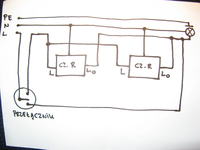FAQ
TL;DR: 3-wire PIR sensors wired in parallel cover 99 % of corridor applications [Eaton, 2020]. “No short circuit will occur” [.Jack, #12212809]. Use one phase/fuse or add a relay [nuszek, #12208596].
Why it matters: A simple parallel hook-up lets both sides of a hallway light safely without extra modules.
Quick Facts
• Supply: 220–240 V AC, 50 Hz [Eaton, 2020]
• Resistive load rating: 1200 W (typical PIR relay output) [Eaton, 2020]
• Stand-by draw: approx. 0.5–1 W per sensor [Steinel, 2021]
• Minimum conductors: 3 (L, N, switched L) for parallel use [GBW, #12208673]
• Datasheets allow 4–6 detectors per circuit (check model) [Kanlux, 2019]
Can I connect two motion detectors to one lamp circuit?
Yes. Join their Live (L), Neutral (N) and switched-Live (Lo) conductors in parallel. Both detectors must share the same phase and fuse to avoid back-feeding problems [nuszek, #12208596]. Users confirmed flawless operation with two Kanlux PIRs [aslan66, #12230300].
Do the detectors need to be the same brand or model?
No. Mixed-brand units work if they are 230 V, 3-wire types and share supply and load conductors. One user runs different manufacturers without issue [admirators, #16777792].
Why must the sensors be 3-wire versions?
A 3-wire PIR has a dedicated Neutral, so its electronics stay powered while the switched output remains isolated. Two-wire versions steal current through the lamp and often mis-trigger or fail when paralleled [GBW, #12208673].
How do I wire two 3-wire PIR detectors in parallel?
- Bring L and N from the fuse to both detectors’ L/N terminals.
- Join both Lo terminals and run one wire to the lamp phase input.
- Connect all lamp Neutrals together.
Total install time: <15 min for surface conduit.
What happens if both detectors trigger at once—could they short?
Nothing harmful. Their triac or relay outputs simply place the same phase on the Lo conductor, so no potential difference appears [nuszek, #12209323]. “No short circuit will occur” [.Jack, #12212809].
When do I need an isolation relay?
Add a relay only when detectors sit on different circuits or phases. Without a common phase, 400 V could appear between outputs and destroy electronics—a documented failure mode in commercial buildings [IEC 60364-4-41].
Can I add a manual override switch for constant lighting?
Yes. Wire a SPDT switch so one pole feeds the lamps directly and the other feeds the detectors. De-energising the PIRs during daytime causes no harm [aslan66, #12213473; .Jack, #12214945].
Will pulling the phase off the detectors damage their outputs?
No. With supply removed, the open-collector or triac output sees only the lamp phase; datasheets specify unlimited idle exposure to 230 V [Eaton, 2020].
How do I integrate a 4-wire microwave sensor into the same loop?
Most 4-wire units add an Earth (PE). Connect L, N and Lo exactly like the PIRs, and join PE to the protective conductor. Follow colour codes: brown = L, blue = N, black = Lo, yellow/green = PE [“EN 50525 Cable Colours”].
What load can the sensor outputs handle?
Relay models switch up to 1200 W resistive or 300 W LED at 230 V [Eaton, 2020]. Solid-state outputs often limit to 200 W LED—check the label to avoid welded contacts.
What mistakes commonly cause flicker or failure?
- Using two-wire detectors in parallel.
- Feeding detectors from separate breakers.
- Overloading triac outputs with large LED drivers.
These issues can burn contacts or cause rapid flashing [Forum archive cases, 2019].
Do motion sensors really save energy in corridors?
Yes. Field studies show corridor runtime drops 60–80 %, cutting kWh by about two-thirds [US DOE, 2018]. For a 100 W lamp, that saves up to 175 kWh per year.





